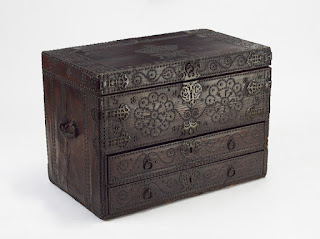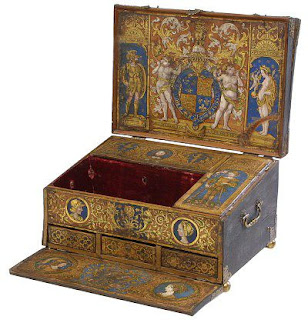Sarris, Nikolas; Classification of finishing tools in Greek bookbinding: establishing
links from the Library of St Catherine's Monastery, Sinai, Egypt.
PhD thesis, University of the Arts London (2010).
URL (UAL Repository)
Abstract:
The thesis examines the decoration of Greek bookbinding, through the study of the leather-covered bindings from the monastery of Saint Catherine in Sinai, Egypt.
The manuscript collection is remarkable for the variety of binding styles that represent mainly Greek but also other bookbinding traditions, including Georgian. Syrian and Eastern European. The examination of the decorative motifs tooled on the leather covered bindings aims to identify the style and characteristics of bookbinding at the monastery. Moreover, links between and evidence for specific bindings and the manuscripts they contain are established by grouping them and relating them to specific binders and bookbinding workshops. The workshops of the monastery are examined in parallel with groups of bindings that were imported into the monastery. The extent to which the trade in books and the circulation of binding techniques between the monastery and the west was a reflection of the relations of the monastery with its dependencies is also explored.
Rubbings of the approximately 5500 tool impressions on the 1195 decorated bindings have provided the core research material. They have been identified, classified and organized into a descriptive electronic database. Imaging techniques have been developed to compare the scanned impressions, which permitted the identification of impressions of the same finishing tools. Based on the identity of their decorative tools and on the process of comparison of their structural features, a number of the bindings have been ascribed to a total of 70 specific workshops, whose dates and origins are explored. 16 of these workshops - nine from the monastery of St Catherine and seven from elsewhere, which produced bindings imported to the monastery, are discussed analytically. In addition to that, 40 original bookbinding finishing tools were discovered at the monastery during this research, which have provided invaluable material for our understanding of the tooling methods and particularities of decorated book covers at the monastery.
The largest corpus of finishing tools used on Greek bindings to date has been compiled to provide a reference tool which will aid future research on Greek bookbinding.
Abstract:
The thesis examines the decoration of Greek bookbinding, through the study of the leather-covered bindings from the monastery of Saint Catherine in Sinai, Egypt.
The manuscript collection is remarkable for the variety of binding styles that represent mainly Greek but also other bookbinding traditions, including Georgian. Syrian and Eastern European. The examination of the decorative motifs tooled on the leather covered bindings aims to identify the style and characteristics of bookbinding at the monastery. Moreover, links between and evidence for specific bindings and the manuscripts they contain are established by grouping them and relating them to specific binders and bookbinding workshops. The workshops of the monastery are examined in parallel with groups of bindings that were imported into the monastery. The extent to which the trade in books and the circulation of binding techniques between the monastery and the west was a reflection of the relations of the monastery with its dependencies is also explored.
Rubbings of the approximately 5500 tool impressions on the 1195 decorated bindings have provided the core research material. They have been identified, classified and organized into a descriptive electronic database. Imaging techniques have been developed to compare the scanned impressions, which permitted the identification of impressions of the same finishing tools. Based on the identity of their decorative tools and on the process of comparison of their structural features, a number of the bindings have been ascribed to a total of 70 specific workshops, whose dates and origins are explored. 16 of these workshops - nine from the monastery of St Catherine and seven from elsewhere, which produced bindings imported to the monastery, are discussed analytically. In addition to that, 40 original bookbinding finishing tools were discovered at the monastery during this research, which have provided invaluable material for our understanding of the tooling methods and particularities of decorated book covers at the monastery.
The largest corpus of finishing tools used on Greek bindings to date has been compiled to provide a reference tool which will aid future research on Greek bookbinding.









